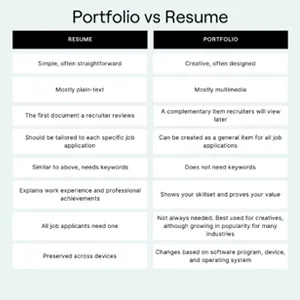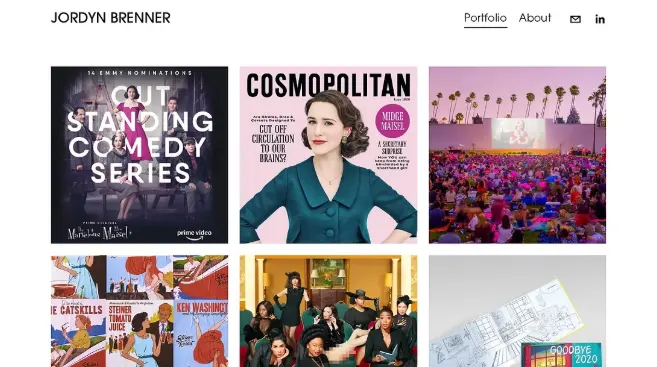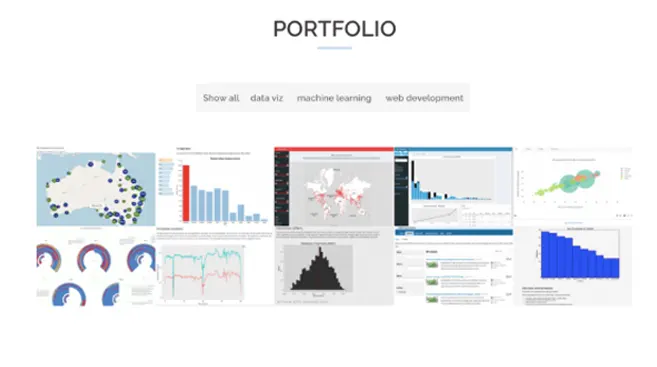
You may imagine a writer or artist when you think of a portfolio. For marketers, however, building a digital marketing portfolio can be revolutionary.
Regardless of your goals—a promotion, a new job, exhibiting your freelance services, or starting a side business—a well-designed portfolio can help you stand out to recruiters and employers.
Nowadays, marketing positions frequently call for innovation. Marketing strategies must draw in viewers, whether it is through the use of attention-grabbing graphics, captivating copy, or captivating videos.
Even if you work in a data-driven position, you still need to show that you can assess and use data to inform marketing plans and offer insightful customer information for optimization.
This blog will walk you through the process of creating your marketing portfolio, providing helpful hints and motivational examples to get you going.
- What’s the difference between a CV and digital portfolio?
- How do you know when to use a CV or portfolio?
- What should you include in a portfolio?
- How do you set up a portfolio?
- 3 great examples of digital portfolios
What’s the difference between a CV and a portfolio?
A digital portfolio website serves the same function as a resume or CV. By presenting samples of your work or marketing campaigns, it draws attention to your training, abilities, expertise, and professional style.
However, because a portfolio is digital, you may connect to your work, landing pages, or microsites with ease and be more creative.
The goal of both resumes and portfolios is to make you stand out by showcasing your abilities and achievements. However, there are several important distinctions to be mindful of.

How do you know when to use a CV or portfolio?
The kind of job you’re going for, where you stand in the recruiting process, and the nature of your work will all influence whether you use a CV or a portfolio as a marketer.
CV/Resume
- For the majority of marketing positions, employers first ask for a résumé or CV.
- It works best when you need to give a succinct, straightforward overview of your credentials.
- A CV is the ideal format to promote your accomplishments if your work isn’t visually appealing, for as when highlighting KPIs or analytics data.
Portfolio
- Perfect for displaying creative work to potential clients, employers, or recruiters, either during the interview stage or when requested in the application process.
- Great for interviews, pitches, or networking, offering tangible proof of your skills and results.
- This is especially crucial for freelancers or professionals in creative fields, such as graphic design, user experience (UX), or content creation.
What should you include in a portfolio?
It’s crucial to know what to put in your digital portfolio before you start constructing it so that you can make sure you have everything you need to wow your future employer or get that job interview.
Your career level and the samples you have to present will determine how big your portfolio should be. If you’re just starting out, you may not have many samples, so concentrate on choosing two or three of your greatest pieces, advises art school Daisie.
Keep the portfolio brief and relevant to the position you’re applying for if you’re using it to apply for a job. You can always add more samples to your website for a more comprehensive display of your work.
These are the essential components of a digital portfolio.
Title Page
Name and Job Title: Make sure your entire name and professional title (such as Social Media Strategist or Digital Marketing Specialist) are prominently displayed.
Provide your phone number, email address, LinkedIn profile, and links to your portfolio or newsletter website in your contact details.
Professional Summary: Summarize your experience, your advantages, and the special contribution you make in two to three sentences.
Table of Contents
Include a clear list of portfolio sections for easy navigation, such as:
- About Me
- Key Skills
- Case Studies
- Analytics Reports
- Certifications & Achievements
- Testimonials
- Creative Work Samples
- Contact Information
About Me
Yes! This is an updated version:
“With more than five years of expertise, I am an SEO specialist with a focus on link-building tactics, technical SEO, and content production. I’m excellent at developing data-driven strategies that increase user engagement, generate organic traffic, and improve online exposure.
Key Skills
“As a digital marketer, my primary competencies consist of:
Proficiency in email marketing techniques, video production, and blogging that increase interaction and conversions is known as content marketing.
Social media: Skilled at sponsored and organic advertising, including retargeting advertisements to increase ROI and reach.
SEO: In-depth understanding of technical, off-page, and on-page SEO to raise search engine ranks and enhance user experience.
Analytics & Reporting: Able to monitor performance and maximize marketing efforts with tools such as Google Analytics and Semrush.”
Tip: Use percentages, bullet points, or icons to provide visual appeal.
Case Studies
Present two or three thorough case studies of accomplished projects.
Include the client or project name for each case study (optional for confidentiality).
Objective: What was the project’s aim? (e.g., “Increase organic traffic by 30% in 6 months.” )
Give a brief explanation of the strategy used, such as “Developed a content calendar targeting high-volume keywords.”
Measureable results should be highlighted, such as “Achieved a 45% increase in organic traffic and 20% higher conversions.”
Tip: For impact and visual appeal, use graphs, performance figures, or screenshots.
Certifications & Achievements
Display your digital marketing-related certificates.
Examples include certifications from the Digital Marketing Institute, Google Ads, and LinkedIn Learning.
Any honors or industry recognitions you, your teams, or the businesses you collaborated with have received.
Tip: For visual appeal, use icons, badges, or logos.
Testimonials
The revised version is as follows:
Testimonials from prior clients, employers, or coworkers might be a nice addition if they are accessible. These recommendations serve as social evidence of your abilities and dependability.
Tip: For emphasis, use stylized text or callout boxes.
Creative Work Samples
Give instances of your artistic creations:
Social media campaigns (e.g., engagement analytics, post screenshots)
Articles or blog entries (links or snippets)
Graphic design or video projects (with links or embedded media)
Projects involving data visualisation (tables or graphs)
Campaigns using email (screenshots, open rates, or CTR analytics)
Public relations initiatives (references to press release samples or media coverage)
Campaigns for paid advertising (screenshots of Google or social media ads based on performance data)
Custom websites or landing pages (screenshots or links)
Tip: For a tidy layout, use galleries or grids.
How do you set up a portfolio?
Let’s get started on the crucial steps for building a portfolio now that you understand its goal, when to use it, and what to include.
1. Select a platform
The good news is that you may start designing your portfolio right away by using one of the many website templates that are available. But it’s crucial to pick one that accurately captures who you are and your brand.
For example, Wix provides a variety of themes and layouts in their AI-powered website builder to assist in creating a unique website. For a more specialised approach, you can use AI tools like WixStudio or Elementor for WordPress to create your own website.

Top tip: Behance is an excellent choice if you’re looking for a place to share and display your creative work in order to attract clients and brands. It’s also a fantastic place to find inspiration because there are so many amazing pieces of work to look at.
2. Choose a good layout and relevant sections
Think on your product or service’s nature when selecting a layout. Which would be more effective: a video at the top or a grid structure for showcasing your campaigns or projects?
Don’t forget to consider the sections you plan to include. A thoughtfully written “About Me” section aids visitors in understanding your experience and qualifications. Make sure to highlight your blog or newsletter, and if you have had any noteworthy media attention or testimonials, think about included a section for those as well.
This is the first time that customers and potential clients will see your business, so take your time. Make sure your homepage is powerful, captivating, and influential. (For ideas, look at these great examples below!)
3. Showcase your best samples
Your portfolio’s primary function is to display your work. Collect your finest samples and identify the ones that best showcase your abilities. Make careful to provide supplementary material that clarifies each example, defining it and showcasing your proficiency.
4. Make it easy to contact you
Making it simple for others to get in touch with you may seem apparent, but it’s important! Provide your email address or think about including a form that will send messages directly to your mailbox. For more methods to interact, don’t forget to provide links to your active social media accounts, such Instagram or Bluesky.
3 Great Examples of Digital Portfolios
It might be difficult to design your digital portfolio, particularly if you don’t know where to start. Examining other people’s portfolios for inspiration and ideas, such as the ones below, is a fantastic way to begin started.
1) Jordyn Brenner

Amazon Studios’ Creative Director, Jordyn Brennan, has a remarkable and eye-catching resume. To grab attention right away, she uses a grid-style layout with strong graphics and vivid colours. Every picture has a clickable link that takes users to a specific page with additional project information.
With only two lines and an email address, her “About” page is surprisingly succinct and direct. Additionally, connections to her LinkedIn page and a direct email address are provided for easy communication.
2. Kathryn L. Hall
Kathryn L. Hall is an accomplished copywriter, SEO & SEM specialist, and brand strategist. She divides her services into three main categories on her online portfolio: creative writing, technical writing, and creative direction. This arrangement not only facilitates visitors’ exploration of her work but also demonstrates the depth of her knowledge. She also provides links to other pertinent initiatives and a personal “Bio” section that provides details about her personality and passions.
3) Yan Holtz

While a CV or resume could draw the attention of recruiters, employers, or clients, a digital marketing portfolio highlights your accomplishments and abilities.
By showcasing your work in an eye-catching, visual manner, a portfolio adds value even if you’re not in a creative field. When it comes to interviews, it may also be a game-changer, enabling you to confidently demonstrate your expertise, stand out, and start significant conversations.
Advance your digital marketing career
Obtaining a digital marketing certification is the quickest and most efficient approach to get started in the digital sector. The foundations are covered, you learn how to incorporate AI into your marketing plans, and you gain critical soft skills with DMI’s industry-aligned Professional Diploma in Digital Marketing.
Additionally, you will acquire practical experience in important channels such as social media, email marketing, SEO, content marketing, and display and video advertising, which will enable you to manage effective campaigns in any sector.

